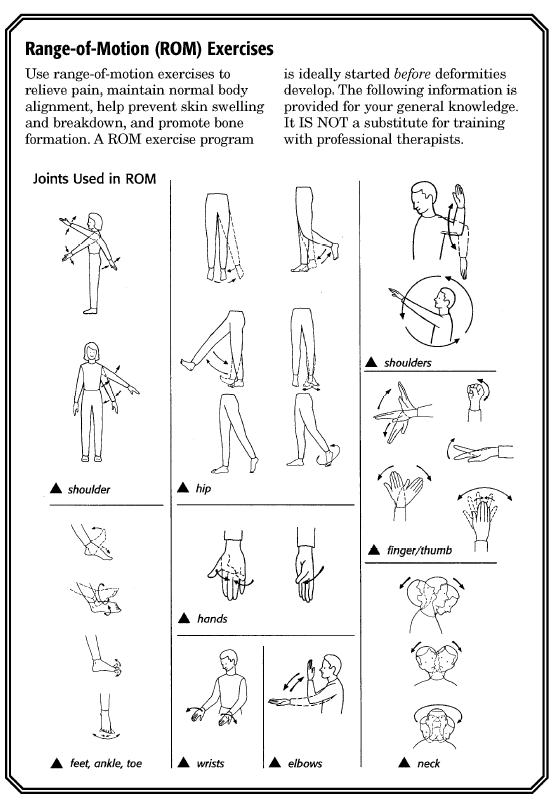
Range of Motion Exercises

Physical and occupational therapies are part of the process of relearning how to function after an injury, illness, or period of inactivity. If muscles are not used, they shorten and tighten, making joint motion painful. For the person in your care, these therapies are key to achieving as much functional independence as possible. Although you may not be asked to assist with these exercises, it is useful for you to know how they help.
A physical therapist treats a person to relieve pain, build up and restore muscle function, and maintain the best possible performance. The therapist does this by using active and passive exercises, massage, heat, water, and electricity. Broadly speaking, a physical therapist:
- Sets the goals of treatment with patient and family.
- Shows how to use special equipment.
- Instructs in routine daily functions.
- Teaches safe ways to move and sets up an exercise program.
Use range-of-motion exercises to relieve pain, maintain normal body alignment, help prevent skin swelling and breakdown, and promote bone formation. A ROM exercise program is ideally started before deformities develop. The following information is provided for your general knowledge. It IS NOT a substitute for training with professional therapists.
Safety Tips for Range of Motion Exercises (ROM)
When helping a person with any activity, first give verbal instruction, then use visual gestures and finally, touch. Here are some things to do when you are asked to help the person in your care exercise at home:
- Communicate what you are doing.
- Use the flat palms of both hands, not the fingertips, to hold a body part.
- Take each movement only as far as the joint will go into a comfortable stretch. (Mild discomfort is okay, but it should go away quickly.)
- Do each exercise 3 to 5 times.
- Use slow, steady movements to help relax muscles and increase joint range.
- If joints are swollen and painful, exercise very gently.
Source: The Comfort of Home: A Complete Guide for Caregivers

Occupational Therapy
Occupational therapy is designed to help people regain and build skills that are important for functioning on their own. The occupational therapist will help the person evaluate levels of function and:
- Tests a person’s strength, range of motion, endurance (the ability to continue an activity or effort), and dexterity (skill in using hands) to do everyday tasks that were done easily before an illness or injury.
- Designs a program that ensures the greatest possible independence.
- Provides training to relearn everyday activities of daily living like eating, dressing, toileting, and bathing.
- Decides whether special equipment is needed, such as wheelchairs, feeding devices, transfer equipment, hand and skin devices.
Arthritis
Arthritis is a common chronic health problem, causing pain, loss of movement, and sometimes swelling
Osteoarthritis is the “wear and tear” type, in which the slippery cartilage that covers the ends of bones in a joint wears out, causing pain and loss of movement as bone begins to rub against bone. It is the most common form of arthritis.
Rheumatoid arthritis is an autoimmune disease, in which the person’s body begins to attack its own joints, causing inflammation and pain. It affects mostly women.
Taking Care of Yourself: Water-Based Exercises
The Arthritis Foundation Aquatic Program (AFAP) is a community-based, group program that uses a variety of water-based exercises to increase physical activity among adults with arthritis. AFAP is offered in some YMCAs and by other community organizations. Participants do not need to know how to swim to participate in AFAP.
Goals are: improved range of motion, muscle strengthening, endurance, day to day function and self-confidence. Each class has balance and coordination activities. The class also has relaxation and breathing activities.
Memory Care- New Skills
As time goes by, it may be necessary for you to learn new skills, such as how to use adaptive devices such as shower chairs and hand-under-hand-assistance for helping the person in your care in the later stages. Training by an occupational or physical therapist will help you to be more competent and confident and will result in less stress for you and the person in your care.


